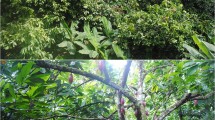Abstract
In Ghana, shade for cacao (Theobroma cacao L.) is becoming a critical issue because of extensive deforestation. Unlike in some other cacao-growing countries, cacao is not grown under the shade of coconut (Cocos nucifera) in Ghana. An experiment to compare the merits of four cacao-coconut intercropping systems with the traditional cultivation of cacao under Gliricidia sepium shade was undertaken at the Cocoa Research Institute of Ghana. Cacao seedling girth was not affected when intercropped with coconut but was significantly (P = 0.01) reduced when intercropped with G. sepium. High density cacao facilitated better early canopy formation. Yield of cacao spaced at 2.5 m triangular (1739 plants ha−1) with coconut at 9.8 m triangular (105 plants ha−1) was significantly higher (P = 0.05) than from the other treatments during 1993/94 to 1995/96. There were no major disease problems associated with intercropping cacao with coconuts. Widely spaced coconuts intercropped with cacao spaced at 3 m × 3 m showed better flowering and gave higher coconut yields, but cacao spaced at 2.5 m triangular under coconuts spaced at 9.8 m triangular was more profitable than the other treatments. Moisture stress was the greatest in cacao system with G. sepium shade and this could be responsible for the low yield of cacao in that treatment. It is suggested that properly arranged high density cacao under widely spaced coconuts can be a profitable intercrop system for adoption by cacao farmers in Ghana.
Similar content being viewed by others
References
Abbas B.S. and Dja'far D. 1989. Sensitivity analysis of cacao cultivation: relative profitability of coconut and Leucaena glauca L. [L. leucocephala] as shade plants, based on a case study at Bah Lias Plantation, North Sumatra. Bulletin Perkebunan 20(2): 97–103.
Alvim R. 1988. Cacao (Theobroma cacao L.) in agrosilvicultural systems. In: Proceedings 10th International Cacao Research Conference, Santo Domingo, Dominican Republic, 17–23 May 1987., pp. 3–14.
Alvim R. and Nair P.K.R. 1986. Combination of cacao with other plantation crops: an Agroforestry system in Southeast Bahia, Brazil. Agroforestry Syst 4(1): 3–15.
Amoah F.M., Nuertey B.N., Baidoo-Addo K., Oppong F.K., Osei-Bonsu K. and Asamoah T.E.O. 1995. Underplanting oil palm with cacao in Ghana. Agroforestry Syst 30: 289–299.
Bastine L., Khader A., Rajamoy L. and Abdul K. 1986. Cost-benefit analysis of intercropping of cacao in coconut gardens. Madras Agric J 73(3): 170–172.
Benneh G. 1987. Land tenure and agroforestry land use in Ghana. In, Land, trees and tenure-. In: Raintree J.B. (ed.), Proceed. of an international workshop on tenure issues in agroforestry, Nairobi, 27–31 May 1985., pp. 163–168.
Brierley J.S. 1987. Land fragmentation and land-use patterns in Grenada. Land and development in the Caribbean. In: Besson K. and Momsen J. (eds), CAB: 7Y Agroforestry-Abs. 1990: 003–00310., pp. 194–209.
Coomans P. 1974. Planting densities for the coconut palm. Oleagineux 29(8–9): 409–414.
Daswir, Harris A.S. and Dja'far D. 1988. Analysis of cacao shaded with coconut (Cocos nucifera) compared with Leucaena glauca in North Sumatra. Buletin-Perkebunam. 19(2): 99–106, CAB: OF Forestry Abs. 1991: 052–00642.
Ekanade O. and Ebge N.E. 1990. An analytical assessment of agroforestry practices resulting from interplanting cacao and kola on soil properties in South-Western Nigeria. Agriculture Ecosystems and Environment 30(3–4): 337–346.
FAO/UNESCO 1999. Soil map of the World-A revised lengend. FAO, Rome, 119 pp.
Glendining D.R. 1960. The relationship between growth and yield in cacao varieties. Euphytica 9: 351–355.
Liyanage L.V.K. 1985. Rationale for intercropping. Coconut Bulletin, Sri-Lanka 2: 31–35.
Mathes D.T. 1986. Economics of intercropping coffee, cacao and pepper under coconut. Coconut Bulletin 3(1): 9–11.
Nair P.K.R. 1979. Intensive Multiple Cropping with Coconuts in India: Principles, Programmes, and Prospects. Verlag Paul Parey, Berlin, 149 pp.
Oladokun M.A.O. 1990. Tree crop based agroforestry in Nigeria: a checklist of crops intercropped with cacao. Agroforestry Syst 11(3): 227–241.
Oladokun M.A.O. and Egbe N.E. 1990. Yields of cacao/kola inter-crops in Nigeria. Agroforestry Syst 10(2): 153–160.
Osei-Bonsu K., Oppong F.K., Amoah F.M. and Acheampong K. 1996. Evaluation of the initial performance of multiple stands of hybrid cacao in Ghana. In: Proceedings 12th International Cacao Research Conference, Salvador-Bahia, Brazil, 17–23 November, 1996., pp. 361–366.
Purseglove J.W. 1976. Tropical Crops-Monocotyledons. 2nd edn. Longman, London.
Salleh M.N. 1997. Enhancing the productive functions of tropical rain forest: a challenging goal. Unasylva 190/191 48: 38–46.
De-Taffin G., Sakra N. and Pomier M. 1992. Planting density and mineral nutrition in coconut plantations. Pleagineux-Paris 47(4): 165–170.
Wood G.A.R. 1985. Establishment. In: Wood G.A.R. and Tass T.A. (eds), Cacao, Vol. 2. Longman, London and New York.
Fagon H.J. and Topper B.F. 1988. Agronomic research on cocoa in Jamaica; 1960–1980 and current trends. Tropical Agric (Trinidad) 65(4): 291–294.
Author information
Authors and Affiliations
Corresponding author
Rights and permissions
About this article
Cite this article
Osei-Bonsu, K., Opoku-Ameyaw, K., Amoah, F.M. et al. Cacao-coconut intercropping in Ghana: agronomic and economic perspectives. Agroforestry Systems 55, 1–8 (2002). https://doi.org/10.1023/A:1020271608483
Issue Date:
DOI: https://doi.org/10.1023/A:1020271608483




